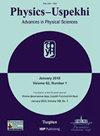Physics news on the Internet: August 2023
IF 3.4
3区 物理与天体物理
Q1 PHYSICS, MULTIDISCIPLINARY
引用次数: 0
Abstract
The discovery of superconductivity [1] at a critical temperature reaching Tc 203 K in the pressure range of 100 to 250 GPa (in diamond anvils) in the H3S system stimulated a flood of experimental studies of high-temperature superconductivity of hydrides at megabar pressures (see reviews [2, 3]). A theoretical analysis immediately confirmed that these record Tc values are due to traditional electron±phonon interaction, and a good description of the experimental situation is due to the Eliashberg±McMillan theory in the limit of a sufficiently strong electron±phonon interaction [4, 5]. Moreover, detailed calculations for a whole number of transition metal hydrides under pressure [4] resulted in the occurrence of a rather large number of such systems with record Tc values. In some cases, these predictions found a magnificent confirmation, in particular, record temperature values Tc 250ÿ260 K were reached experimentally in the LaH10 system [6, 7]. These studies were of great importance, mainly because they clearly demonstrated the absence of substantial restrictions on Tc in the framework of the electron±phonon mechanism of Cooper paring, where it was conventionally accepted thatTc cannot exceed 30±40K.After the appearance of papers [6, 7], it became clear that the discovery of room temperature superconductivity, which had been only the dream of a few theoreticians over many years [8, 9], was not too far off. And now this barrier has been crossed, for in recent paper [10] superconductivity with Tc 287:7 1:2 K (i.e., nearly 15 C) has been obtained in the CÿHÿS system at a pressure of 267 10 GPa. The authors took advantage of the fact that hydrogen sulfide H2S mixes well with methane CH4. Such a mixture (with an additional injection of H2) underwent high-pressure photochemical synthesis (using laser radiation) and was examined at pressures from 100 to 300 GPa. Fairly convincing data were obtained on a sufficiently narrow superconducting transition (from resistive measurements) with Tc from 175 to 287 K upon pressure variation from 175 to 267 GPa that were confirmed by measurements of diamagnetic response (Meissner effect) at pressures from 175 to 200 GPa and by direct (resistive) measurements of the upper critical magnetic field (Tc lowering to 9 T under the action of the external magnetic field) near Tc. These measurements showed that the system under studywas a conventional second-order superconductor and theHc2 values atT 0 could reach 62 or 87 T (depending on the applied extrapolation to T 0). Unfortunately, the authors have not yet exactly determined the structure of the investigated superconducting phase CÿHÿS because of the difficulties in X-ray measurements in light-atom systems (smallness of the X-ray scattering cross section). It is believed that this problem will be solved in the nearest future in a combination of direct experiments and modern methods of theoretical simulation of high-pressure stable structures [4]. It is practically certain that the limit Tc 15 can be overcome in future experiments with hydrides under high pressure and, perhaps, also in the case of experimentally obtaining metallic hydrogen.互联网物理新闻:2023年8月
在H3S体系中,在100 ~ 250 GPa的压力范围内(在金刚石砧中),临界温度达到Tc / 203 K的超导性[1]的发现,激发了大量关于兆巴压力下氢化物高温超导性的实验研究(见综述[2,3])。理论分析立即证实了这些记录Tc值是由于传统的电子±声子相互作用,而对实验情况的良好描述是由于Eliashberg±McMillan理论在一个足够强的电子±声子相互作用的极限[4,5]。此外,在[4]压力下对整个过渡金属氢化物的详细计算结果表明,出现了相当多的具有记录Tc值的这种体系。在某些情况下,这些预测得到了惊人的证实,特别是在LaH10系统中实验达到了创纪录的温值Tc / 250ÿ260 K[6,7]。这些研究是非常重要的,主要是因为它们清楚地证明了在Cooper配对的电子±声子机制框架下,Tc没有实质性的限制,在Cooper配对中,通常认为Tc不能超过30±40K。在论文[6,7]出现之后,人们清楚地认识到,室温超导的发现已经不远了,而这只是少数理论家多年来的梦想[8,9]。在最近的一篇论文中,在压力为267 10gpa的CÿHÿS体系中获得了Tc / 287:7 1:2 K的[10]超导性(即接近15°C)。作者利用了硫化氢H2S与甲烷CH4混合良好的事实。这样的混合物(与额外的H2注入)进行高压光化学合成(使用激光辐射),并在100至300 GPa的压力下进行检测。在175到267 GPa的压力变化下,从175到287 K的足够窄的超导转变(来自电阻测量)获得了相当令人信服的数据,这一数据通过在175到200 GPa的压力下的抗磁响应(迈斯纳效应)测量和在Tc附近的上临界磁场(在外部磁场的作用下Tc降低到9 T)的直接(电阻)测量得到了证实。这些测量结果表明,所研究的系统是一个常规的二阶超导体,hc2值atT皓0可以达到62或87 T(取决于对T皓0的应用外推)。不幸的是,由于光原子系统的x射线测量困难(x射线散射截面小),作者尚未准确确定所研究的超导相CÿHÿS的结构。相信在不久的将来,直接实验和高压稳定结构理论模拟的现代方法相结合将解决这一问题。实际上可以肯定的是,在将来的高压氢化物实验中,或者在实验中获得金属氢的情况下,可以克服Tc ? 15的极限。
本文章由计算机程序翻译,如有差异,请以英文原文为准。
求助全文
约1分钟内获得全文
求助全文
来源期刊

Physics-Uspekhi
物理-物理:综合
CiteScore
4.70
自引率
7.40%
发文量
60
审稿时长
6-12 weeks
期刊介绍:
Physics-Uspekhi (Advances in Physical Sciences) is a translation of the authoritative Russian-language review journal in physics, Uspekhi Fizicheskikh Nauk, first published in 1918. The papers cover a wide spectrum of the world''s scientific research in physics and associated fields by authors from France, Germany, United Kingdom, Italy, Japan, Sweden, the USA and other countries which successfully complement contributions by authors from Russia and other states of the former Soviet Union.
Physics-Uspekhi (Advances in Physical Sciences) covers:
Reviews of Topical Problems
Physics of Our Day
Instruments and Methods of Investigation
Methodological Notes
From the History of Physics
Conferences and Symposia
Book Reviews
Selected Physics News from the Internet.
 求助内容:
求助内容: 应助结果提醒方式:
应助结果提醒方式:


